Southern Tier Nursing Practice
Throughout the Decades
District 5 of the New York state Nurses' Association was organized December 2, 1919, stemming from the alumni associations of the three local nursing schools. Before that, each was an individual member of the state organization. Lillian Mix Warner was the first president.
The schools were founded at: the Binghamton Asylum for the Insane (1894); Binghamton City Hospital (1895); and Lestershire Hospital (1912). Subsequently their names were changed to Binghamton state Hospital, Binghamton General Hospital, and Charles S. Wilson Memorial Hospital. In response to changing times, the schools closed: Binghamton state in 1973, Binghamton General in 1978; and C.S Wilson Memorial in 1980.
On May 17, 1934, District 5 was incorporated by Andrew J. McNaught, Justice of the Supreme Court. The charter members and board of directors were: Rita Huener, Maude Carpenter, Pauline Degnan, Beatrice Moran, Alma McCafferty, Ida McFee, Mabel Anderson, Ruth Teal Rockwell, Blanche Hotaling, Margaret Doyle, and Dolly Lampman.
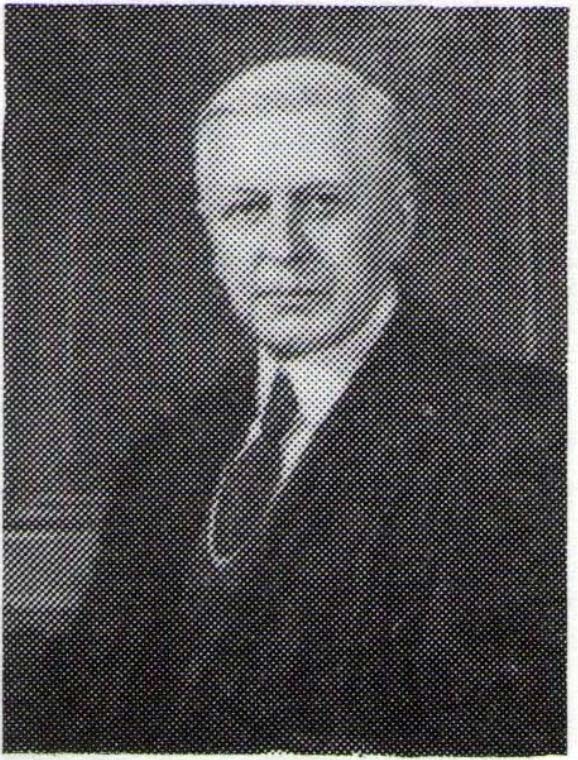
Andrew J. McNaught
Ruth Teal Rockwell, the sole surviving charter member, graduated from Binghamton City Hospital in 1928. After one year of employment as night supervisor at Binghamton City Hospital, she went to Fordham Hospital's Receiving Ward and general duty; then to Beth Israel in New Jersey, where she was first an obstetric nurse and, then supervised the Children's Ward for 5 years. She returned to Binghamton City Hospital and represented District 5 at the 1936 Convention in New York City. On May 23, 1942, she joined the Army Nurse Corps. She was assigned duty in the European theater. She worked in Veteran's Hospital in Aspenwall, Pennsylvania in 1946. Shortly thereafter, she returned to Binghamton and was employed in the offices of Drs. Molyneaux and Beauman. She also practiced private duty nursing. In 1952, she married a widower with four children.
Mrs. Rockwell currently resides in a long-term health care facility and continues friendships with other nurses in the community.
The district was originally composed of Tioga, Broome, Chenango, and Tompkins Counties. In 1930, Tompkins County was integrated into District 3. Delaware County was added to District 5's region in 1933, but, with Chenango County, was reconfigured into District 15 when it was organized in 1937.Today, District 5 is composed of Broome and Tioga Counties.
In 1924, District was the first to set rates for private-duty nursing services. This trend-setting move had to be discontinued, as the state nursing association did not approve of the practice. In later years, the state changed its position and in 1952, District 5 private duty nursing rates were higher than the state minimum.
The group's wholistic approach to practice was illustrated by the variety of topics and audiences they addressed at meetings. The most concerning illnesses of the era were addressed: pneumonia, tuberculosis, and cancer; social issues such as juvenile delinquency and the effects of television on the public; practice issues: "New trends in Medicine and Nursing Education", "The History of Nursing", and the passage of the Nurse Practice Act. Some programs were open to the public.
They were creative in imparting their subject matters, developing skits and pageants, as well as lecture formats. "The History of Nursing" was a pageant performed for the Broome County Medical Society in addition to its presentation at a membership meeting.
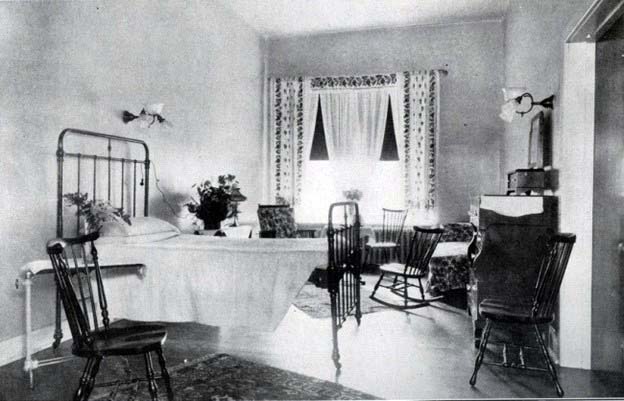
Private Duty Nursing in the 1940s
The New York State Nurse Practice Act was a significant piece of legislation requiring the memberships' attention. It was the first in the nation to define the roles of nurses for hire and identify the distinction between registered and practical nurses. It also required licensing for these two levels of practice. District 5 was the resource to which concerns on the part of the community were addressed regarding the impact of the law on patient care.
The nursing care needs of World War II occupied the District 5 members in the early 1940's, as shown by their participation in the National Survey of Registered Nurses to determine the availability of nurses to care for patients both at home and abroad.
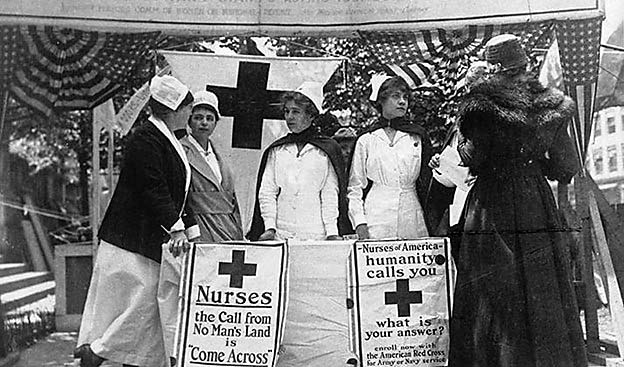
Red Cross Committee
The Red Cross Committee of District 5 was formed to coordinate efforts to recruit nurses into the Army or Navy Nurse Corps. District members garnered the support of Hamlin's Drug Store, who placed a full-page ad in the Binghamton Press that included an Honor Roll of those serving.
Among the many who enlisted were: Iris Craig Liner, who graduated from Binghamton City Hospital. She immediately began her service career in 1942 and became a Captain of the Army Nurse Corps serving in England. Between 1945 and 1950, she returned to civilian life and was active on both the district and state levels of the New York State Nurses' Association. In 1950, she returned to the Army to serve in the Korean War. During her service there, she earned the Bronze Star, authored a manual for nursing care used by the Korean Army and received a citation from the Surgeon General of the Korean Army for her part in setting up indigenous teams capable of handling cranial and nerve injuries in Korean hospitals. She attained the rank of Lieutenant Colonel and was selected as one of four "Women of the Year" by Major General William F. Dean, U.S.A.
Iva Robinson, president of District 5, resigned in 1942 to become a Second Lieutenant in the Army Nurse Corps.
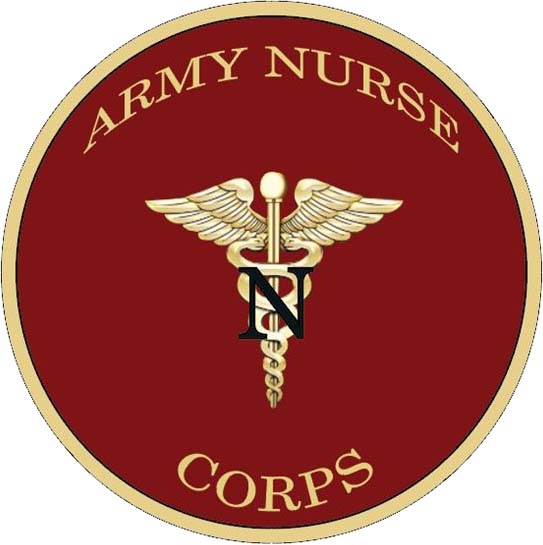
Army Nurse Corps Logo
Bernice ("Bernie") Finch Kneller enlisted in 1943, one year after graduating from Wilson Memorial Hospital School of Nursing. She was influenced by watching many of her contemporaries join up, but also by the thought of her brother, Eugene, who was serving in the Pacific theater as part of the Army Air Corps. She entered the Army as a Second Lieutenant serving in England and eventually nursed the casualties from D-Day. Mrs. Kneller's mother saved her daughter's correspondence from that time. The Broome County Historical Society published them in 1999, as a book, Bernie's Letters Home. In compiling the manuscript, Mrs. Kneller was able to include previously censored details to document her experiences more accurately.
While the major thrust was to encourage the enlistment of nurses into the Army and Navy Nurse Corps, considerations were also made to meet the need for nursing care in the community.
The Private Duty Nurses Section supported the drive to alleviate nursing care shortages, exacerbated by the increased incidence of polio in the community. They called upon their ranks to participate in group nursing. Their opportunities for and scope of practice were rigidly controlled in 1945, when those designated as available for serving in the Army or Navy Nurse Corps were not permitted on the registries of the local hospitals. It was decided that only the most seriously ill patients could receive private duty nursing, and only after agreement by the physician in charge, the hospital administrator, and the director of nursing that the patient's well being required the service.
Letters from graduate nurses to Clarice Knapp, Director of Nursing and the School of Nursing at Wilson Memorial Hospital, expressed their concern for the nursing needs of the community. Mrs. Knapp responded that, due to the availability of student nurses and the loyalty of those nurses remaining home, Broome County was in a better position for providing nursing care than many communities.
The war was the primary focus, but not the only one for District 5. The Men's Section was formed in 1941, to encourage the participation of male nurses in their professional organization. Albert Launt was named chairman. In 1944, Mr. Launt was elected Second Vice President of the New York State Nurses' Association, the first male to hold office on the NYSNA Board of Directors. The Men's Section was dissolved in 1946 and became a committee of District 5.
In 1945, the Blue Cross Hospitalization Plan was made available to members and many subscribed. To date, three members continue to carry their health insurance through this plan.
As the war ended, the concerns of the district members were redirected to the needs of returning veterans and innovations in medicine and nursing. Meeting topics were devoted to diseases of wartime (such as malaria); the new antibiotic, penicillin; and how to rehabilitate (both physically and psychologically) and assimilate returning veterans into their previous industrial jobs.
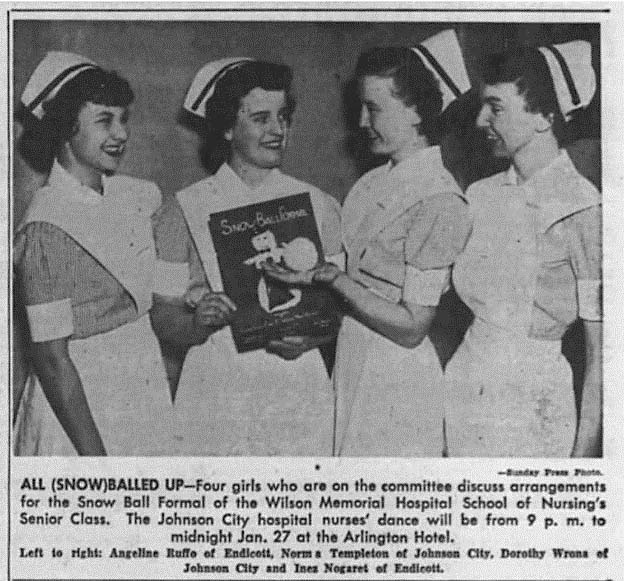
Wilson Hospital School of Nursing Senior Class Members - January 22, 1950 (From Press and Sun Bulletin)
An opportunity for progress in preparing individuals for professional nursing practice presented in 1946 and was enthusiastically supported by District 5. Triple Cities College, formerly a part of Syracuse University, was established in Endicott. Initially, liberal arts courses would be offered to nurses seeking baccalaureate degrees until nursing faculty could be provided, potentially in 1948. It was hoped by Rowena Dutcher, the new Director of Nursing and the Nursing School at Wilson Memorial hospital, that the nursing school would affiliate with the college. Triple Cities College was relocated to Vestal and became Harpur College, enlarged to the State University of New York at Binghamton and then Binghamton University. Mrs. Dutcher's dreams of affiliation never came to fruition, but many local diploma and associate degree nursing graduates have attained baccalaureate and advanced nursing degrees from Binghamton University over the years.
Concern for the provision of health care to their patients motivated the district's members to cooperate with the Broome County Medical Society in efforts to defeat legislation for National Socialized Medicine in 1948.
Implementation of the Nurse Practice Act, passed by the New York State Legislature in 1938, was of critical concern in 1949. Execution of the law had been postponed due to nursing shortages. Broome and Tioga County nurses had prepared themselves to meet the requirements of the law. This and the importance of fulfilling its intent on delivering quality patient care was not lost on District 5 members. To promote local support, the district sponsored a program aimed at educating members of the Dental and Medical Societies, Directors of Nursing Services, alumni presidents; and student nurse representatives of the necessity of implementing it. These concerns were voiced by District 5 president, Albert Launt and published by the Binghamton Press in 1949: “nearly 1,000 registered nurses and ‘probably more than an equal number of practical nurses or persons who expect to be licensed as such seem to have taken a beating.' He added “ ‘the hospitals want cheap labor and if the Stuart Bill becomes law they will have it. If the Nurse Practice Act becomes effective and the licensing is required, hospitals will have to pay more for qualified employees.’”
The superintendent of Binghamton City Hospital argued that the hospital would have to violate the law to continue their present services. This was evidently a common and successful mission of hospital administrators throughout the state as the implementation of the law was again postponed until 1950.
The drive for recruitment of new members to District 5, an ongoing challenge was particularly successful from 1947 to 1962. This was accomplished through the efforts of Pauline Degnan, a charter member of the organization when incorporated in 1934 and faculty member of the Wilson Hospital School of Nursing. Miss Degnan devised a system of dues payment that incorporated membership to both the school's alumni association and District 5. The graduate nurses' loyalty to and association with Miss Degnan prompted them to willingly join, thus swelling the membership rolls and resulting in many years of awards from the New York State Nurses Association for increased membership.
Public concerns over the use of the atomic bomb determined some activities of District 5 in the 1950s. The Advisory Committee for Civilian Defense, made up of hospital administrators, chiefs of staff of the Triple Cities Hospitals, presidents of the medical society and nursing organizations, and the civilian defense director, was formed in Broome County in 1950. Mrs. Norma O'Hara, District 5 president, was appointed to serve on the committee.
In 1951, District 5 and the Practical Nurses Association sponsored a program for its members, "Medical and Nursing Aspects of Atomic Explosion", attended by nearly 1000 people, a few of whom were not nurses.
The Broome County Defense Council and Civil Defense Training Committee held annual test exercises for nurses. Mary Robling was an active leader in this campaign, involving district members in planning and implementation.
Education regarding the most concerning illnesses of the time and advancement in many areas of treatment was provided at meetings and through other forums. An institute, "The Nursing Care of the Poliomyelitis Patient" was presented at both Binghamton City and Wilson Memorial Hospitals in 1950. Concern for the community's understanding of polio prompted the group to also hold a public meeting about the topic. Thirty-five volunteers from the district administered polio immunization to school-aged children at community clinics held in 1957.
in June of 1951, the School and Public Health Committees sponsored a Tubercuiosis institute addressing "Rehabilitation of the T.B. Patient", "Clinical Tubercuiosis", and "Newer Drugs and Treatment in Tuberculosis."
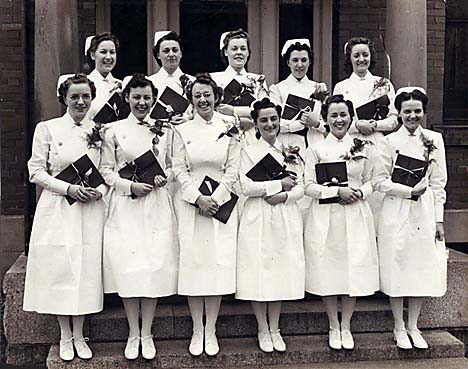
Nursing Education in the 1950s
"Intravenous Therapy in Emergency Hospitals" was the topic of a general meeting in 1953, "Cobalt Therapy" in 1957.
District 5, with the American Heart Association and the Practical Nurses Association, conducted teaching sessions for nurses in 1955 on 'Common Cardiac Conditions", "The Nurse's Responsibility in Assisting an lndividual to Live With Heart Disease", and "National, State, and Local Facilities Available to Cardiac Patients".
Volunteers from District 5 participated in the Clinitron Testing Unit at the diabetes clinic in 1956.
Recruitment of individuals to the nursing profession guided many activities. In 1951, three $200 scholarships were established for students to attend the three local nursing schools. Teas were held for local high school guidance counselors to advise them on the necessary courses students interested in entering nursing education should take. In 1954, District 5 was invited to participate with medical, dental and other health professions in a health careers program at the Roberson Museum. The district had an ongoing policy of making loans to nurses seeking advanced education.
Meeting the nursing needs of the community continued as a priority for District 5 in 1954. The board of directors was requested by the Triple Cities Hospital Council to accept the formation of a training school for practical nurses. The proposal was unreservedly supported. Clarice Knapp came out of retirement to serve as director of the school.
The Public Relations committee in 1956 began bi-annual mailings of a flyer to inform all members of the activities of the district and state organization and keep them apprised of nursing issues. This was the precursor to "Facts for Five", the current membership newsletter. The format and layout has evolved from a simple typewritten format to a more lively presentation incorporating more sophisticated graphics and sometimes columns addressing nursing issues.
A committee initially composed the newsletter; in 1988 Carol Korutz became the first formal editor. It is circulated to members five times a year. Although the appearance of the newsletter has changed, its purpose, to communicate to District 5 members and stimulate participation in their activities, continues.
In the 1960's there was continued focus on issues of the previous decade. In March 1960, a "Health Careers Conference" sponsored by the Public Health Education Committee of Broome County, composed of health service agencies, doctors, dentists, and nurses, was held for eleventh year high school students and their guidance counselors. At the suggestion of District 5, it was a two-day program. On the first day, the counselors were acquainted to the needs and available opportunities in the represented health fields. The second day, invited students who had expressed interest in careers in health care, viewed exhibits with their newly informed counselors and explored individual areas of interest. The program was so successful that in the fall of the same year a similar conference was held and included ninth year high school students. A third session was added to include attendance of parents and interested adults in the community.
Anna Suplee and Mary B. Robling received citations from the Broome County Medical Society for their clinical assistance in the "Sabin on Sunday" Clinic.
The district continued to participate in the preparatory efforts of the Broome County Civil Defense Council when the March meeting in 1963 was heId at the county control center. Participants discussed the nurses' role in civil defense and refreshments were served "shelter style."
Area nurses supported the community's need for expanded health care services. Mary B Robling served as Chairperson of the Broome County Social Planning Council in 1963. Working with the Public Health Committee of the Board of Supervisors, this group paved the way to creating the present County Health Department.
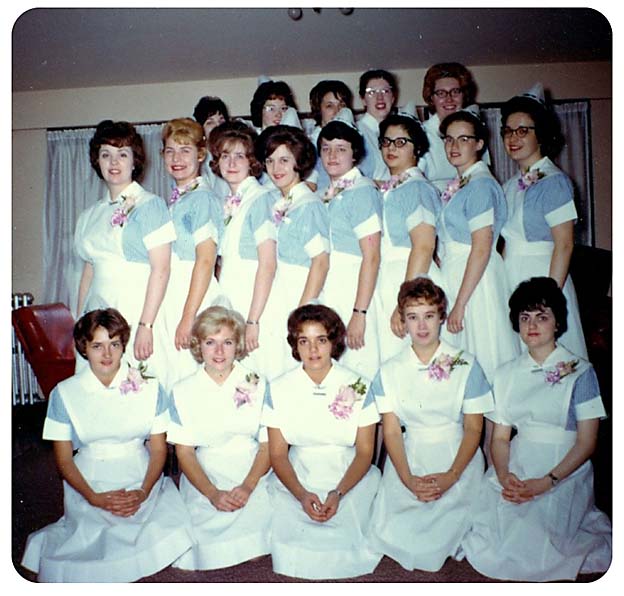
Class of 1964 – Binghamton General School Of Nursing
In January 1960, Lilla Pareis brought to the members' attention a request by Broome Technical Community College to approve the establishment of an Associate Degree nursing program. The group appointed a committee to study the request and bring their findings to the membership. There was a sense of skepticism regarding the program, as the members were unfamiliar with the mission and educational format of technical schools. In the interest of fulfilling the community's needs for nurses, when Miss Pareis presented the committee's report and endorsed support of the program, the members unanimously approved the proposal in February of the same year.
The guest speaker at the September 1966 meeting, Marian Hazard, was received with particular interest. She was the Director of Nursing at Mohawk Community College, addressing the development and progress of two-year nursing programs. The Broome Technical Community College program was to begin in the fall of 1967.
Many present-day graduates of what is now known as Broome Community College have gone on to achieve further degrees in nursing. They have been and continue to be participative members of District 5.
The Education Committee, newly formed in 1967, collaborated with the Wilson Hospital Alumni Association to present a "Cancer Teaching Day" in 1969. Topics at membership meetings were "The Use of the Computer in our Hospitals Today", held at Our Lady of Lourdes Hospital, where the attendees had the opportunity to tour the computer room; "Human Relations and the Imagination at Work", 'Hemodialysis", and "The Nurse and the Dying Patient'.
In 1968 and 1969 the newly formed Maternal and Child Health Conference Group, chaired by Marion Brown, provided a series of pre-natal classes for unwed mothers. The instructors were Miriam Wright from Binghamton General Hospital, Alice Decker from C.S. Wilson Memorial Hospital, and Olga Roma and Polly Getkin from Ideal Hospital. The participants of the classes appraised the classes to be very worthwhile.
Throughout the 1960's and 1970's, legislative activities were focused toward the goals identical to those of the state association, especially revisions to the Nurse Practice Act. Legislative Committee members were diligent in lobbying activities aimed toward local lawmakers support of passing Amendments 130, and 139. District 5 members attended Arden House, the New York State Nurses' Association conferences focused on the state association's role in nursing education. At a membership meeting in November 1970, the attendees reported on the conference.
The revised act was successfully passed, and the new amendments were enacted in 1972. It clarified the definition of nursing practice as the independent diagnosis and treatment of human responses to actual or potential health problems that would be consistent with existing medical regimens and clearly differentiated between the practice of the registered professional nurse and the licensed practical nurse.
This revolutionary piece of legislation, brought about through intensive efforts by nurses statewide, was a monumental victory for nursing practice throughout the nation establishing registered professional nursing as an independent profession. It also emphasized that the educational level for entry into practice was inconsistent and required resolution. Diploma schools were diminishing, but still existed; associate, baccalaureate, and advanced degree nursing programs were on the rise. The Regent's External Degree Program was an additional educational option for registered nursing licensure, introduced in 1973.
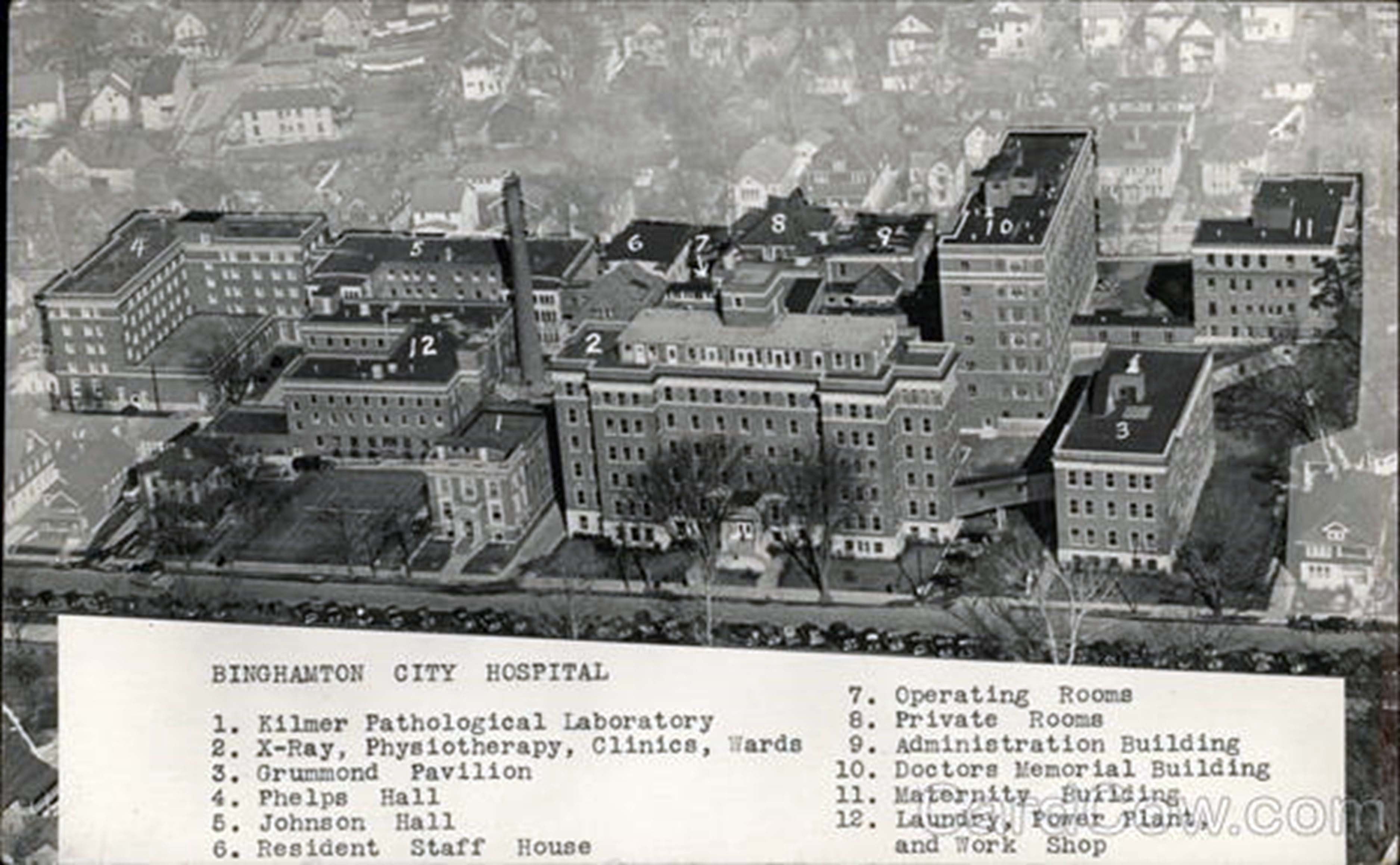
Binghamton City Hospital
In comments regarding the closing of the Binghamton General Hospital in 1978, Francis Feldsine made reference to the issue: "At a meeting of the New York State Nurses Association in 1974, a resolution, known as the 1985 proposal was adopted; ‘To move the education of nurses into the university setting and by 1985 require a Baccalaureate degree in Nursing as a requirement for licensure for professional nursing'" ("The Circle", May 1978). District 5 members overwhelmingly supported the "1985 Proposal", with Frances Feldsine, outgoing Director of the Binghamton General Hospital School of Nursing, its staunchest local advocate.
Other diploma school faculty felt ambivalent about the proposal. While a baccalaureate degree was seen as most fundamental in educating registered nurses for the demands of the evolving profession, they continued to recruit students to their schools but were not offering college credits for their courses to facilitate their graduates' eventual achievement of a degree in nursing.
Through the years, educational entry level was discussed in many District 5 forums. A workshop patterned on the Arden House Conferences was held May 21, 1975. One hundred and ten nurses attended and the participants initiated requests that further such sessions be offered. In addition, a questionnaire to increase awareness of the subject was distributed to 1800 employed nurses. The 400 responses were invaluable to District 5 leaders' consideration to the direction they should take for the future.
The local television stations were enlisted to host forums to inform the public about the significance of the legislation change.
Health care management became an issue in the 1970's. When the NY-Penh Health Systems agency organized in Broome County, Districts 5 and 15 formed a Community Planning Group for Nursing and resolved to be the voice for nursing in the area. Letters and statements from the membership of both districts were sent to the NY-Penn Health Planning Council and the Central New York Regional Medical Program informing them of this intent. District member Denise Murray became Executive Director of the NY-Penn Health Systems Agency. Mary K. Dempsey and Margaret Manley appointed to and served for several years on the NY-Penn board of directors.
One of the recommendations of health systems agency was to establish a Pediatric Nurse Practitioner program at SUNY Binghamton. While this has not been possible to implement, the university began offering a new curriculum for Family Nurse Practitioners in 1977. Graduates of this program are active in the current leadership and activities of District 5.
In 1971, an effort to forge a relationship between District 5 and the Broome County Medical Society was initiated. As a result, "A Page for Nursing" was included for several years in Broome County Medicine, a publication of the Society. The current board of directors of District 5 is again seeking to establish an effective collaboration with the Broome County Medical Society, to support the practice of both disciplines in the community and find a middle ground for the support legislation that promotes efficient, safe, and high quality health care access nationwide.
The 1973 creation of the Nurse Practice Committee was an affirmative response to the changes in the definition of the registered nurse, the need to address assimilating nurses to this development, and a vehicle to be pro-active to anticipated legislation that would affect nursing practice. Denise Murray and Regina Fives were the first co-chairpersons. The overlap of functions of the Nurse Practice, Education, and Program Committees eventually resulted in the formation of the Nursing Practice and Education Committee.
The Gerontology conference group, led by Shirley Paulauskas and Dorothy Belansky, formed in 1973 to address the distinctive needs of the community's aging population. They presented many programs, two of which were "Geriatric Standards of Practice" in 1976 and "Nursing Care of the Elderly in 1977. The Elder Education Task Force chaired by Marlene Benson formed in 1995. Their goal was to identify and intervene in the education of local elders in response to a specified area of need. They obtained a grant from the New York State Nurses Association Foundation and initially surveyed area professionals serving elders, but this approach was unhelpful to their goal. They next sought support from Action for Older Persons, who sponsored a random survey of 4000 registered voters age 60 or over. Results of this survey identified the need for the Elder Exercise Program. The task force became a committee of District 5, co-chaired by Joan Eisch and Masha Britten, when implementation of the project began in 1997. In cooperation with the Broome County Office for Aging, pamphlets regarding how to get started, who to call for information, and information to health care providers who would be monitoring patients interested in initiating and maintaining exercise efforts were published and distributed in 1998. Joan Eisch met with the board of directors in February, 2000 to declare the project complete. The board agreed to using the balance of grant monies for funding a display of the project at the Nurse's Day breakfast and then dissolving the committee.
A 1973 effort to pilot a peer review program was sponsored by the Broome County Medical Society and the NY-Penn Management Corporation and participated in by the Broome County Dental Society and District 5, NYSNA lncorporated. "The Experimental Medical Care Review Organization (EMCRO)" proposal was not funded, but local nursing leaders continued efforts to participate in health care policy developments. The presidents (or their representatives) from Districts 3, 4, 5, and 6 formed a task force in the Central New York Professional Standard Review Organization area, in 1976. Their intent was to prepare nurses to meet their responsibilities in evaluating and maintaining patient care and promote nurse participation in PRSO's whose function was to review health care provided to Medicaid and Medicare patients.
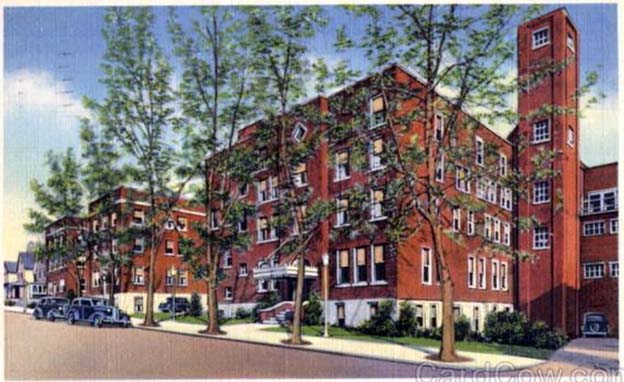
Lestershire Hospital
Georgeanna deWalder, in 1977, coordinated the first District 5 sponsored course for continuing education credit, "An Introduction to Physical Assessment". It was taught by SUNY Binghamton School of Nursing Faculty for RN's interested in building on their assessment skills. The course was repeated in 1978, coordinated by Frances Feldsine.
At the 1974 New York State Nurses Association's Annual Convention plans for the construction of the Center for Nursing were announced with a call for pledges from the constituent districts. District 5 members questioned the need for proposed project Alice Whitcombe championed the cause, describing her observations of the cramped headquarters and a filing system that consisted of boxes piled up next to desks. This prompted a change of heart and District 5 members willingly approved their contribution to the endeavor.
Meeting topics of the 1970's, not previously highlighted, but which illustrate community health care needs at the time were: "Community Facilities and Methods of Drug Treatment", "The Family Practice Program at Wilson Hospital" (a new area of physician specialty), " Third-Party Reimbursement and the Expanded Role of the Nurse", "Primary Care Nursing", 'Kids with Kids', 'Human Sexuality in Nursing Practice", and “Allergies: Their Etiology and Management”.
The concept of nurses as a labor force had to be confronted, as increasing numbers of nurses were electing to be represented by collective bargaining organizations. Anna Suplee, former Districts president who personally opposed the unionization of nurses, expressed the inclination that, if nurses felt compelled to seek labor representation, they should choose their professional organization to benefit their cause. Peggy Rooney, from the staff of the New York State Association, spoke to the membership on the topic of "Labor Relations and Health Care", November 13, 1978
To date, several union elections have been held in the area represented by District 5. So far, all organized nursing labor initiatives have been voted down. None of these organizing efforts have elicited the support of the collective bargaining unit of the New York State Nurses’ Association.
The CHENSUS (Chenango/Susquehanna) Run was held in 1979-1982, co-sponsored by District 5 and the Binghamton Parks Association for the benefit of the American Cancer Society and the American Heart Association. The event was created to direct the attention of the local press to nurses and portray them to the public as active, healthy people. In her annual report to NYSNA, dated May 12, 1980, Frances Feldsine made note of a remark by a young participant that “she wants to be a nurse when she grows up because they’re organized and they run a good race.”
The 1980's was a period of intense legislative activity. The Legislative Committee added two non-nurse consumer representatives to their group and developed a district effort for rapid action on legislative issues by putting into effect a telephone tree to inform members of legislative alerts and how to present the position of nurses to lawmakers. Many of the membership meetings invited guest speakers from NYSNA and other organizations to speak on the current issues. Student nurses were recruited to participate in lobbying efforts, thus educating them in current legislative issues and role modeling professional responsibility to protect and expand on health care policy and nursing practice concerns. In 1989, a new effort to educate local legislators about the roles of nurses was conducted, "Keep Pace with A Nurse". The lawmakers met nurses at Lourdes and United Health Services Hospitals, Hilltop Johnston Campus, CASA, and the Tioga County Health Department, and observed their activities and fulfillment of responsibilities.
In 1983, the Education and Program Committees collaborated on initiating the Annual Nurses' Day Champagne Breakfast, to unite nurses and promote the image of nursing in the community. The means to accomplish this was to annually bestow the title 'Honored Nurse' upon a local nurse who. had made an impact on patients and colleagues. The intent of this event is best documented by excerpts from 'The Professional Nurse', Alice Whitcombe's address to attendees on May 6, 1983.
"We are gathered today for the purpose and pleasure of recognition of merit to give friendly notice of our appreciation, to pay attention to, and to salute nurses – as well as to acknowledge the validity of the independent practice of nursing... In a sense, we are honoring too the numbers who have gone before (us) in this valley... The nursing profession continues to undergo rapid change in. assuming new roles and different relationships with the consumer and other health professionals. Nurses are very vulnerable to conflict due to the pivotal role they assume in the delivery of care, the new functions and responsibilities they are undertaking, the acquisition of more power and control in the health setting, the interdependence with other professionals, and the differentiation between professionals... Let us accept the challenge to grow ourselves and to enable others to grow – as we celebrate recognition of past success, present potential, and future hope."
The celebration held on the first Thursday in May is the most widely attended program on the District 5 calendar. Additional awards are presented for legislative and public relations contributions to nursing efforts and recipients of the Hila Kinney Scholarships are announced. The appropriate committees developed eligibility criteria for each category of award between 1988 and 1994. It also the most intense vehicle for raising funds for scholarships – holding raffle of prizes donated by area businesses and health care agencies, selling buttons and magnets with nursing themes, as well as soliciting donations. District solicits the participation of vendors to display current products and services to offset the costs of the event.
The champagne toast was discontinued in 1988 in respect to the awareness of the problem alcohol poses to the public, including nursing colleagues. The format included guest speakers on topics of interest until 1999; when the board decided that more area nurses could attend if the length of the program shortened to 2 1/2 hours from 4 hours. In order to provide an educational opportunity a Poster/Networking session is available during registration. Alberta Wilmot created a banner for display at the breakfast and other District 5 functions in 1994.
In recent years, the New York State Nurses Association has contributed funds that have supported attendance of senior nursing students from Binghamton University and Broome Community College. This has prompted some graduates practicing locally to join the district.
In 1988, the American Medical Association's House of Delegates, in response to physician concerns over the nursing shortage, moved to pilot training "Registered Care Technologists". They perceived that nursing was not effective in its efforts to alleviate the shortage. In reality, the use of RN's at the bedside was increasing, but the numbers of individuals entering nursing practice was not. In addition, many bedside nurses were entering into advanced roles that enhanced the health of the public, but taking them away from bedside care. The American Nurses Association, with other national organizations and state nurses associations, conducted a campaign to oppose this new category of bedside caregiver. Among their concerns were: (1) the activities of the "RCT" in care giving were already the responsibilities of nursing - aides, practical and registered nurses. Nurses nation-wide urged the AMA to support nursing organizations in their efforts to recruit new practitioners to the profession, rather than create an additional health care provider category. (2) The "RCT's" would be employed by the hospital and be accountable to the physician. However, as the physicians' presence at the bedside was limited and the technologists would assume some nursing functions, the ANA raised questions about the RCT's practicing nursing without a license, as well as the whether nurses would be liable for the RCT's actions in their presence. (3) The educational curriculum for high school graduates to achieve the proposed 3 levels of practice had not been designed, but it was intended that with two to 18 months of training, the RCT's would be registered to carry out medical protocols at the bedside. This raised the concern of both nursing and health care consumer organizations for errors in care giving. (4) There was no concrete data to support the AMA theory that this new category of caregiver would alleviate the shortages in bedside nursing.
District 5 confronted the problem by creating the RCT/Nursing Shortage Ad-Hoc Committee in 1989. This group identified that the public and our medical colleagues did not understand the valuable function of nurses. They immediately and energetically set on a campaign of information about nursing and to enhance the image of nursing in the Southern Tier. They spoke at local junior high and high schools to encourage recruitment into the profession. They met·with members of the Broome Medical Society, to clarify the role of nurses in provision of health care and support Medical Society research to recruit RN's for long-term care facilities. Louisa Ivan (District 5 President), Anthony Disser (Sigma Theta Tau, Zeta Iota Chapter President) and Mary Ellen Gaudet (staff nurse) appeared on a local talk show to educate the public to the roles of nursing and the current concerns of practice. "Letters to the Editor" were published in the Binghamton Press, to inform the community about the proposal and its shortcomings, as well as to advise about more realistic strategies to increase the availability of nurses.
The Committee contributed to the scholarship fund, sponsoring a bake sale, and soliciting monies from drug companies and individuals.
Their most creative effort was the creation and marketing of a button that identified the unique qualities a nurse offers those in her care. "You NEED a NURSE" button - “
If you need
Nurturing
Understanding
Respect
Skill
Education
You NEED a NURSE”.
The heart-shaped stethoscope graphic was borrowed from a brochure from the American Nurses Association. Committee member Marianne Parker wrote the "NURSES" acronym.
The membership also gained insight into managing personal stress, DES screening, rape, premenstrual syndrome, family violence, Hospice care, communication disorders, and legal aspects of nursing practice, through speakers at their regular meetings.
The last decade of the century has been focused on protecting the public from health care chaos. District 5 responded to the closing of the Well Child Clinics at the Broome County Health Department, the Adolescent Unit at Binghamton Psychiatric, and ambulance service by the Binghamton Fire Departments with the release of position statements deploring the loss of these services.
The legislative committee developed and published a handbook to guide nurses in the lawmaking process and effective ways to influence reform.
Despite crucial issues of health care reform and nursing practice legislation, the legislative committee was unable to retain a formal membership and dissolved in 1994. The members formed the new Legislative Interest Committee and each was assigned a task of choice in legislative activity. The district's president coordinated their efforts. Currently, the board of directors designates a Legislative chairperson to keep the members apprised of lawmaking activities significant to health care and nursing practice. The board members are called upon to volunteer when specific action is needed in response to issues.
District 5. celebrated the 75th Anniversary of its establishment in 1994. The March/April Issue of "Facts for Five" announced this milestone and included member responses to "Why I Joined District 5". At the·November meeting, the anniversary reception featured speakers Alice Whitcombe, Margaret Manley, and Shirley Frailey. Each addressed a segment of the history of the organization. The speeches were published in subsequent issues of the newsletter, to share with members unable to attend the reception.
Topics of new interest at membership meetings included: bicycle helmet safety, HIV/AIDS, a "Workshop for Mandated Reporters – Child Abuse", and "Alternative therapies" (such as therapeutic touch and herbal medicines).
As the district exited the old century and entered the new, President Linda Jowett felt that visibility of District 5 was needed in the community. While individual members actively volunteer their time and expertise to local causes, the support of the professional organization not evident. The Community Service Committee, co-chaired by Ann LaMarca Major and Judy Conlon, first met on August 1, 2000. Their first project is to provide primary prevention in adolescent parenting. Mom's House is the first agency targeted. It supports adolescent parents with babysitting services while they are attending school and provides education on all aspects of parenting. Mom's House willingly accepted the district's offer to present educational programs to its staff and young parents. On June 19, 2001, co-chairpersons of the Public Relations and Membership Committee, Thomasita Carlson and Michelle Codner re-certified the staff in Cardiopulmonary Resuscitation, saving Mom's House the class registration costs.
A schedule of classes on the subjects of asthma, growth and development and rashes in children will proceed this fall.
The committee identified the need to re-establish a speakers' bureau in order to provide community education. They also are encouraging people to become organ donors. At the Annual Nurses' Breakfast this year, Judy and Ann conducted a booth to accomplish these projects. Attendees could sign onto the speakers' bureau and/or be provided witness to their signatures on the backs of driver's licenses in the organ donation section.
While there are a few thousand registered nurses in Broome and Tioga Counties, membership in District 5 hovers around 200. The Public Relations and Membership Committee tried new strategies to encourage nurses to join a well as to promote a positive image of nursing to the community. A colorful flyer was created and distributed for posting at sites of nursing employment.
A poster was constructed for display at the Nurses Day Breakfast. The central feature, a collage of members' pictures was devised with the intent that those who view it might recognize members they know and be motivated to join too. Membership applications were available with the poster presentation.
District 5 was featured in a television advertisement of a local car dealer whose commercial spots highlight the efforts of community-oriented groups and their projects.
The Press and Sun Bulletin published an announcement, sponsored by District 5 and others on May 11, 2000 to honor Nurses Week. The item was composed by the Public Relations and Membership Committee .
Dr. Loretta Ford was guest speaker at a Nurses Week Event co-sponsored by The Decker School of Nursing at Binghamton University, the Susquehanna Chapter of the Coalition of Nurse Practitioners and District 5, NYSNA, Incorporated. Dr. Ford shared the challenges and milestones of her career with the group and her visions of what the future of nursing can hold.
District 5 Vice-President Naomi Ervin was elected to the American Nurses Association Congress on Nursing Practice and Economics in July 2000.
Elaine Cichowski-Doupe received the Legislative Award at the Nurses Day Breakfast, 2000 for her continued efforts to keep the board notified of significant legislative issues. In 2001, Marita Florini, past Legislative Chairperson and District 5 President, re-assumed this role. Issues of third-party reimbursement for nurses, insurance coverage for preventative care in women's health, patient's rights and safety in health care provision, and protection of the nurse practice act are the current concerns for District 5 members and nurses nationwide.
The challenges faced by District 5 of the New York State Nurses' Association mirror those of professional nurses throughout the nation. The establishment and then dissolution of various committees and focus groups document the ebb and flow of trends in meeting patients' needs and the identification of new health problems. Meeting topics addressing cultural and socio-economic issues of patients illustrate the wholistic approach District 5 nurses have always taken in caring for them.
The ongoing enterprise to establish nursing, in the minds of the public and health care colleagues, as an independent and essential profession is evidenced through every decade, as District 5 members implemented strategies to increase recruitment into the profession and participation in the organization. There were lobbying efforts to pass legislation to that clearly defined the scope of nursing practice and reimbursement for independent practice, as well as to emphasize to lawmakers the central role nurses provide in wellness and illness care.
The "1985 Proposal" might be considered lost but not forgotten. While it was not passed, entry level of education remains a concern of nurse leaders on both the state and district levels of the New York state Nurses' Association.
Nursing care is like the air people breathe or the food they eat. It is taken for granted until the quality is poor or none is available. The nurses in District 5 continue to provide high quality nursing care to the community. They strive to provide sufficient numbers of nurses to do so. They continue to advance the profession by implementing strategies to rally public support and attain recognition for the knowledge, skills, and integrity of all nurses.
Sources
- Smith, Robert, NYSNA Public Relations Consultant (1952). "Tri-Cities Noted for Good Labor relations, Unique Medical Plan." New York State Nurse 24(1), pp. 3-7, 26-32.
- District News sections from New York State Nurse, 1938-1967.
- District5Annual Reports to the New York State Nurses Association, 1951- 2001.
- District 5 Archives
- Kneller, Bernice Finch (1999). Bernie's Letters Home. Broome County Historical Society.
- Pavri, Julie, M. (2000). Honoring Our Past, Building Our Future: A History of the New York State Nurses Association. Q Publishing LLC, Franklin, VA.
- American Nurses Association brochures (1989): "It's time we start caring for ourselves as much as we care for our patients." and "Defeating the RCT and Similar Proposals"
- "The Circle", 12(9) published by Binghamton General Hospital for employees and contained in the archives of the C.S. Wilson Memorial Hospital School of Nursing.
